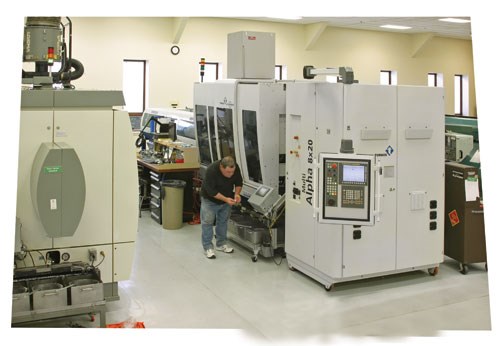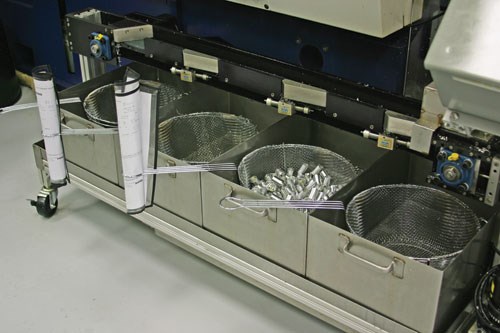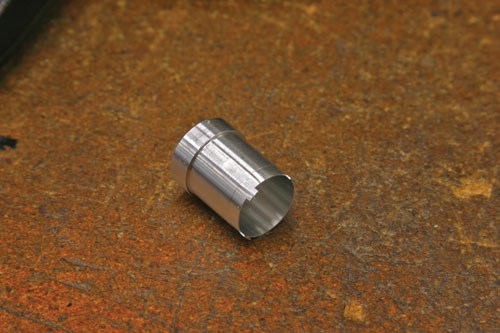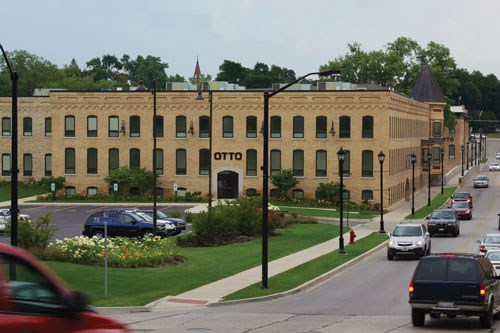A Company's Road to Lights-Out
Consolidation is usually about companies. However, this Illinois shop has found that consolidating turning spindles from eight stand-alone lathes into a single CNC multi- spindle, then running it lights-out is the way to go.
John Lang, Otto Engineering’s machine shop manager, has a load of energy and a healthy sized batch of unbridled enthusiasm for an exceptionally clean shop, great technology and high productivity. After 22 years on the job, he oozes confidence without being one bit pretentious. He knows what he wants and is willing to fight for it.
In 2002, Mr. Lang’s shop floor comprised 14 single-spindle machines, bar fed, with some equipped with live tooling. Then a CNC six-spindle multi caught Mr. Lang’s eye at IMTS. With no “screw machine” experience, he proposed the seemingly crazy idea of running the company’s high mix, low volume work across the multi-spindle to reduce costs and work-in-process. The man had a vision that wasn’t necessarily shared by others.
Featured Content
“I put my job on the line for that machine and fought almost every department in the building because at the time, everybody wanted to send our work to China,” Mr. Lang recalls. “I was convinced that the way to beat China is through technology and responsiveness. We had to come up with a way to make our parts inexpensively and quickly, and I saw the multi-spindle as a way to do that.”
The Fight Begins
“Everybody wanted to go to China, and I’m not on that bandwagon. I’m not the little puppet that sits at the table and does this,” Mr. Lang says, as he bobs his head up and down. “We fought like cats and dogs in this building.” When the dust had settled, he emerged as the victor—Otto would add its first multi-spindle machine. He says the high-end CNC multi-spindle technology can scare some people. “People are afraid of it. I don’t get that, and I never have.”
Mr. Lang’s partner in crime and shop supervisor, Tom Secreto, says, “Now that we’ve done it (implemented a multi-spindle), they’re sold on it,” he says. The efficiencies achieved in terms of floor space, increased productivity and lower overhead were benefits that the company president and owner, Tom Roeser, would acknowledge and later fully support.
All the parts in this family would stay in the U.S., at Otto. Mr. Lang was able to prove his point with quality, speed and an impressive ROI. “We received bigger, quicker payback. Even though we’re making them faster, we’re making them better,” he says.
The company team grouped its parts into families and employed preset tooling techniques for quick change-overs from part to part. Soon, many jobs were being moved from the single-spindle lathes onto the multi-spindle for increased productivity, taking cycle times down from a minute or more to 10 seconds or less.
For the next 4 years, the first multi-spindle gained work and was eventually maxed out. Mr. Secreto adds, “At 97-percent capacity, we couldn’t move up. One little hiccup, and we were done. That’s when we started looking for a new multi-spindle.”
If Six is Good, Eight is Better
In January 2008, Otto Engineering’s Tornos MultiAlpha 8×20 was delivered. It was another big investment, but the company was in the position to buy it in the most efficient way—cash. The company has never financed a machine. With the proof of concept from the first machine, risk was low.
The addition of the new machine technology gave the company an edge. “The new machine has better backworking capabilities than our old multi,” Mr. Secreto says. “That means I can get more sophisticated parts in the machine. And with eight spindles instead of six, I can put more tools in the machine, and I can get more families of parts. Instead of taking something out and putting something in, it’s already there and ready to go.”
The eight-spindle MultiAlpha gave the company additional stations for more sophisticated part production. “There were parts that we have on this machine that we would have liked to put in the other multi, but we couldn’t because there were too many features, grooves, threads and double-threads, and as the machine goes around, you run out of stations. With eight spindles, you can add a groover and an extra threading operation or another slot, for example,” Mr. Secreto adds. “When we bought our first multi-spindle, we didn’t understand. If I do a ten-piece order on our first multi-spindle, I have to put an operator there for 5 to 6 hours to set it up and make the ten pieces, and then the machine sits. But with the Tornos, we can slip it in a similar family, and bang—you’ve got ten pieces.”
Cycle times have been reduced as well. The Tornos’ sophisticated backworking has allowed the company to finish parts complete that couldn’t be done on its previous multi. As an example, Mr. Lang describes one part that once took 4 minutes with secondary operations after being run on the old multi-spindle. It now runs 100 percent complete on the Tornos in a mere 20 seconds.
Mr. Secreto now has about 100 part programs in the machine’s control, with more to come. He believes he’ll have 300 within 3 years. A machine like this is typically purchased for making a million copies of one part. “We will set up this machine for 30 pieces,” Mr. Lang explains. “We’ll set it up for 1,000 pieces, 50 pieces, 15 pieces and 3,500 pieces. Once the program is in there, that’s when it becomes really good. We don’t like to keep any inventory on our switch cases; the Tornos multi-spindle machine is the inventory.”
Cut and Paste Programming
Mr. Lang explains its concept for accelerating the part programming for the multi-spindle. “A lot of our parts are similar. The differences are small, so we’re just cutting and pasting. Therefore, we’re not really engineering each one of those jobs. When we say we’re going to make 300 programs, we absolutely are going to make 300 programs. But we may not have “made” anything on the last 220 of them because we cut this over here and that over there. It’s the back half of this part, the front half of another part, and the inside is identical. So we’re just cutting and pasting.”
The company philosophy for setups in the future differs from other shops using multi-spindles. “Production planning for us is not by families or by processes, it’s by tools,” Mr. Lang says.
To keep the production flow moving, Mr. Secreto has a philosophy and a strict edict. “Everything must be in that same thought process; use the smallest number of tools possible,” he says. “Even though I may have to take an extra cut with that tool, you don’t want to add another tool because that adds more time in the setup.”
The concepts for these processes were not newly developed. They were disciplines learned through the years. Reducing the number of tools started on the old single-spindle machines with the idea of trying to designate certain pockets for certain things. Almost every shop will designate “that’s my cutoff station,” or the “rough turn pocket,” and “this is where we’re always going to drill and bore.”
“We found that these processes are reducing setup time,” Mr. Secreto says. “Even though all of our cycles aren’t optimized all the time, it didn’t matter when we’re making 100 or 500 pieces. Because we’re saving so much time in the setup, 10 or 15 or even 20 seconds added on to the cycle time wasn’t affecting the cost of the part. So we were reducing setups across the whole shop. And then when we saw these CNC multi-spindles at IMTS, we were thinking, ‘Wow, we could do this same concept on one of those, and it would be unbelievable’.”
Lights Out
Mr. Lang and Mr. Secreto thought of a unique idea for running lights-out for the company’s JIT production on the multi-spindles: an automated parts catcher with four baskets. As the machine-mounted parts manipulator places the finished part in the chute, it is deposited on a conveyor belt, and one of four gates are opened by the machine’s controller directing the parts into a basket designated for that job. “We can have it run X amount of parts in each basket, and it will automatically go to other jobs without anybody being there,” Mr. Lang says. “Eventually, we’re going to have four bins on the other side that are identical. Then, let’s say it’s a weekend, so we can set this for as many as 12 programs and let it run.”
One key to Otto’s lights-out approach is the part programs. “Obviously, you can’t change tools when we’re not in the shop. So programs have to be set for parts that are similar enough to use the same tools.
We have families of parts like that,” Mr. Secreto explains.
Mr. Lang looks to the future for even more flexibility. “Once we get closer to the 300 programs, we can group the parts accordingly, but we’re not there yet. Even if we’re running the same part, it will separate the parts by hour, for example. So if I have a 20-hour run, I’m going to program the parts separator to change bins every 4 hours. That way, if there is a quality issue, we can backtrack it to possibly one bin. Or, we can change it over and drop one part here, one part there, one part there, and one part there,” he says, pointing to each individual basket. “It’s as flexible as we need.”
Currently, the company runs two manned shifts and a third shift that’s unmanned. “We work 9 hours, and then they (second shift) work 9 hours and then there’s an unmanned shift,” Mr. Secreto says.
Mr. Lang adds, “Especially on the multis, we’re running lights out all the time. That’s part of the idea of this parts separator we built.” The automated systems, created by Otto, also reduce labor costs. “We only have two people on the two multi-spindles—one on days and one on nights. And they’re only part time on these machines. So, it’s really one-third of a person working per machine.”
The internal part extraction system is a key feature of the Tornos system. “Rather than drop off into a chute, which generally tends to fill up with chips, the extractor catches those parts. That’s a huge advantage because now we’re physically bringing each one out of the machine individually instead of going down in the chips,” Mr. Lang says.
For lights-out operation, he settled on one stock size for the Tornos machine: 7/8-inch 2011 aluminum. It’s a critical strategy for increased production on the multi-spindle. “We never change the material. If we’re making a 1/2-inch diameter case, we’re making it out of 7/8-inch diameter. The material is always in there.”
Over time, Otto plans to move all of its aluminum jobs that are of the proper size range to the multi-spindle for increased productivity. “We’re pulling the aluminum work that is seven-eighths and less off our other machines and moving it over to the multi-spindle machine,” Mr. Lang says.
He then elaborates on his theory on why today’s CNC multi-spindles may be misunderstood. “Most people, when they think of a multi-spindle, think of a 3-day setup. But we’ve taken care of that through engineering and preset tooling. Going from one program to the next, we schedule 15 minutes for setup. In some cases, it’s less than that,” he says.
Because of the huge number of aluminum parts in its catalog, the company runs through quite a bit of aluminum stock, giving them a buying advantage. “We actually get a price reduction because we buy so much 7/8 inch, so they give us a better price than buying all these different sizes,” Mr. Lang explains.
Keeping It in the U.S.A.
Mr. Lang takes great pleasure in keeping his work in the U.S. for the sake of his company and the industry in general. “We kept the anodizing operation in the United States, our barstock supplier is in the United States, the tooling people who are selling us the tools are in the United States. Hydromat in St. Louis made some money on this. The application engineer kept his job. I mean, the trickle effect of a single U.S. manufacturer is amazing. We want it to stay here.” By creatively applying technology, like the Tornos multi-spindle, Mr. Lang can afford to keep his business in the States.
RELATED CONTENT
-
Bar Feeder Basics
Some primary factors are often overlooked when considering how to justify the implementation of a bar feeder for turning operations.
-
Automation in High-Mix, Low-Volume Turning Applications
Turning shops are familiar with automation for high-volume work, but the shifting landscape to smaller batch sizes has created new challenges.
-
Smart Workholding Device Measures and Monitors
Sensor and IIoT technology combine to enable these chucks and mandrels to automatically monitor workholding parameters and measure part features to ensure process stability.












